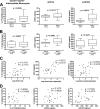Shift in monocyte apoptosis with increasing viral load and change in apoptosis-related ISG/Bcl2 family gene expression in chronically HIV-1-infected subjects
- PMID: 25355877
- PMCID: PMC4301149
- DOI: 10.1128/JVI.02382-14
Shift in monocyte apoptosis with increasing viral load and change in apoptosis-related ISG/Bcl2 family gene expression in chronically HIV-1-infected subjects
Erratum in
-
Correction for Patro et al., Shift in Monocyte Apoptosis with Increasing Viral Load and Change in Apoptosis-Related ISG/Bcl2 Family Gene Expression in Chronically HIV-1-Infected Subjects.J Virol. 2015 Jul;89(13):6970. doi: 10.1128/JVI.00735-15. J Virol. 2015. PMID: 26041838 Free PMC article. No abstract available.
Abstract
Although monocytes and macrophages are targets of HIV-1-mediated immunopathology, the impact of high viremia on activation-induced monocyte apoptosis relative to monocyte and macrophage activation changes remains undetermined. In this study, we determined constitutive and oxidative stress-induced monocyte apoptosis in uninfected and HIV(+) individuals across a spectrum of viral loads (n = 35; range, 2,243 to 1,355,998 HIV-1 RNA copies/ml) and CD4 counts (range, 26 to 801 cells/mm(3)). Both constitutive apoptosis and oxidative stress-induced apoptosis were positively associated with viral load and negatively associated with CD4, with an elevation in apoptosis occurring in patients with more than 40,000 (4.6 log) copies/ml. As expected, expression of Rb1 and interferon-stimulated genes (ISGs), plasma soluble CD163 (sCD163) concentration, and the proportion of CD14(++) CD16(+) intermediate monocytes were elevated in viremic patients compared to those in uninfected controls. Although CD14(++) CD16(+) frequencies, sCD14, sCD163, and most ISG expression were not directly associated with a change in apoptosis, sCD14 and ISG expression showed an association with increasing viral load. Multivariable analysis of clinical values and monocyte gene expression identified changes in IFI27, IFITM2, Rb1, and Bcl2 expression as determinants of constitutive apoptosis (P = 3.77 × 10(-5); adjusted R(2) = 0.5983), while changes in viral load, IFITM2, Rb1, and Bax expression were determinants of oxidative stress-induced apoptosis (P = 5.59 × 10(-5); adjusted R(2) = 0.5996). Our data demonstrate differential activation states in monocytes between levels of viremia in association with differences in apoptosis that may contribute to greater monocyte turnover with high viremia.
Importance: This study characterized differential monocyte activation, apoptosis, and apoptosis-related gene expression in low- versus high-level viremic HIV-1 patients, suggesting a shift in apoptosis regulation that may be associated with disease state. Using single and multivariable analysis of monocyte activation parameters and gene expression, we supported the hypothesis that monocyte apoptosis in HIV disease is a reflection of viremia and activation state with contributions from gene expression changes within the ISG and Bcl2 gene families. Understanding monocyte apoptosis response may inform HIV immunopathogenesis, retention of infected macrophages, and monocyte turnover in low- or high-viral-load states.
Copyright © 2015, American Society for Microbiology. All Rights Reserved.
Figures






Similar articles
-
Monocyte Based Correlates of Immune Activation and Viremia in HIV-Infected Long-Term Non-Progressors.Front Immunol. 2019 Dec 6;10:2849. doi: 10.3389/fimmu.2019.02849. eCollection 2019. Front Immunol. 2019. PMID: 31867010 Free PMC article.
-
Antiretroviral therapy in HIV-1-infected individuals with CD4 count below 100 cells/mm3 results in differential recovery of monocyte activation.J Leukoc Biol. 2016 Jul;100(1):223-31. doi: 10.1189/jlb.5AB0915-406R. Epub 2015 Nov 25. J Leukoc Biol. 2016. PMID: 26609048 Free PMC article.
-
Soluble CD163 made by monocyte/macrophages is a novel marker of HIV activity in early and chronic infection prior to and after anti-retroviral therapy.J Infect Dis. 2011 Jul 1;204(1):154-63. doi: 10.1093/infdis/jir214. J Infect Dis. 2011. PMID: 21628670 Free PMC article.
-
The HIV Reservoir in Monocytes and Macrophages.Front Immunol. 2019 Jun 26;10:1435. doi: 10.3389/fimmu.2019.01435. eCollection 2019. Front Immunol. 2019. PMID: 31297114 Free PMC article. Review.
-
Monocyte and macrophage dysfunction as a cause of HIV-1 induced dysfunction of innate immunity.Curr Mol Med. 2010 Nov;10(8):727-40. doi: 10.2174/156652410793384141. Curr Mol Med. 2010. PMID: 20937022 Review.
Cited by
-
Gene Expression Profiles of HIV/AIDS Patients with Qi-Yin Deficiency and Dampness-Heat Retention.J Altern Complement Med. 2016 Nov;22(11):865-879. doi: 10.1089/acm.2015.0350. Epub 2016 Oct 19. J Altern Complement Med. 2016. PMID: 27759429 Free PMC article.
-
Comparative Transcriptional Analysis Identified Characteristic Genes and Patterns in HIV-Infected Immunological Non-Responders.Front Immunol. 2022 Jan 28;13:807890. doi: 10.3389/fimmu.2022.807890. eCollection 2022. Front Immunol. 2022. PMID: 35154126 Free PMC article.
-
Interactions of Monocytes, HIV, and ART Identified by an Innovative scRNAseq Pipeline: Pathways to Reservoirs and HIV-Associated Comorbidities.mBio. 2020 Jul 28;11(4):e01037-20. doi: 10.1128/mBio.01037-20. mBio. 2020. PMID: 32723919 Free PMC article.
-
Transcriptome Sequencing of Peripheral Blood Mononuclear Cells from Elite Controller-Long Term Non Progressors.Sci Rep. 2019 Oct 3;9(1):14265. doi: 10.1038/s41598-019-50642-x. Sci Rep. 2019. PMID: 31582776 Free PMC article.
-
Reduction of apoptosis by proanthocyanidin-induced autophagy in the human gastric cancer cell line MGC-803.Oncol Rep. 2016 Feb;35(2):649-58. doi: 10.3892/or.2015.4419. Epub 2015 Nov 13. Oncol Rep. 2016. PMID: 26572257 Free PMC article.
References
-
- Guadalupe M, Reay E, Sankaran S, Prindiville T, Flamm J, McNeil A, Dandekar S. 2003. Severe CD4+ T-cell depletion in gut lymphoid tissue during primary human immunodeficiency virus type 1 infection and substantial delay in restoration following highly active antiretroviral therapy. J Virol 77:11708–11717. doi:10.1128/JVI.77.21.11708-11717.2003. - DOI - PMC - PubMed
-
- Badley AD, Pilon AA, Landay A, Lynch DH. 2000. Mechanisms of HIV-associated lymphocyte apoptosis. Blood 96:2951–2964. - PubMed
-
- Gekonge B, Giri MS, Kossenkov AV, Nebozyhn M, Yousef M, Mounzer K, Showe L, Montaner LJ. 2012. Constitutive gene expression in monocytes from chronic HIV-1 infection overlaps with acute Toll-like receptor induced monocyte activation profiles. PLoS One 7:e41153. doi:10.1371/journal.pone.0041153. - DOI - PMC - PubMed
Publication types
MeSH terms
Substances
Grants and funding
LinkOut - more resources
Full Text Sources
Other Literature Sources
Medical
Research Materials
Miscellaneous

